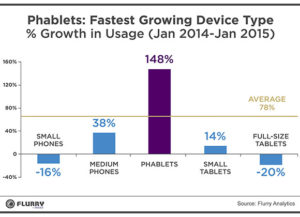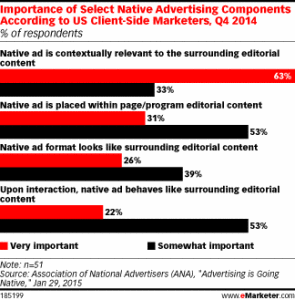A spike in ‘phablet’ usage, declines in newsstand sales, the must-have component of native advertising, an e-book revenue dip, and more are covered in this month’s installment of TFP’s Media Metrics roundup.
To help you keep up with trends and prepare for changes just around the corner, each month we compile excerpts from some key reports covering issues affecting the publishing and media industries. Here are our top picks.
Launch of Apple’s iPhone 6 Plus Helps Grow ‘Phablet’ Usage 148% (Talking New Media)
- Between January 2014 and January 2015, use of ‘phablets’ like the iPhone 6 Plus and the Samsung Galaxy Note grew 148%.
- That, in turn, drove significant growth (measured by the number of sessions) for the overall mobile and app industry, with usage jumping 78% during the same period.
- Meanwhile, small tablet use grew only 14% year over year, while full-size tablet usage fell 20%.
- The report said music, media and entertainment, sports, and news and magazines were the content categories that grew the fastest on phablets. For example, use of phablets to access or view sports content grew 427% more than that on other types of device.
Newsstand Sales Take a Huge Tumble (Media Life Magazine)
- The Alliance for Audited Media reported newsstand sales fell 14.2% in the second half of 2014, the biggest hit since 2008.
- Total circulation decreased 2.2% in the same period, which included a 1.5% decline in paid subscriptions. In contrast, the AAM said that sales of digital editions were up 11%.
- The report said that the shutdown of Source Interlink, a major distributor, as well as a reduction in the number of weekly issues published last year contributed to the decline.
What’s the Must-Have Component of Native Advertising? (eMarketer)
- A study by the Association of National Advertisers (ANA) found that 66% of client-side marketers in the U.S. plan to increase their native advertising budgets in 2015. That compares with 55% reporting that they were increasing their budgets in 2014.
- The ability to create native ads that are “contextually relevant to the surrounding editorial content” was cited as an important factor by 96% of ANA survey respondents, with 63% saying it is very important.
- Two-thirds of respondents said it’s important for native advertising to look like surrounding editorial content, but only 26% said it’s very important.
- Providing clear disclosure on native advertising was important to two-thirds of respondents, while 13% said they didn’t feel it was necessary.
Publisher Revenue Plummets as the Novelty of E-Books Wane (Good E-Reader)
- Quarterly results at major publishers like Penguin Random House and Simon & Schuster were lower than expected: S&S saw its profits dip 5.6%, while at Penguin, profits went down about 12%. The report pointed to a lack of bestselling titles and lower e-book sales.
- At S&S specifically, Publisher’s Weekly reported that e-books made up 23.2% of sales in 2014, down from 24.4% in the previous year. It said total digital revenue, including downloadable audio, accounted for 26.4% of revenue in the same period, down from 27.1% the year before.
Magazine Industry Boasts 10.1% Rise in Readership (Women’s Wear Daily)
- While newsstand sales saw declines, magazines grew audiences 10.1% across print, digital, video, and the web in the past six months, with a total audience of 1.59 billion, according to the Brand Audience report.
- It listed People as the brand with the largest audience (nearly 44 million), followed by Better Homes and Gardens (39.4 million), and AARP The Magazine (35 million).
- In the beauty and fashion category, Cosmopolitan came out on top with an 18.7% total audience share (160.6 million), the report said, while Glamour and Vogue came in second and third, with 11.4% and 9.6% audience share, respectively.
- The report attributed the results in part to a significant rise in mobile users: from 11% to 18% year over year, an increase it said would have been larger had there been no decline (from 71% to 64%) in consumers using both print and digital.
Alas, 2014 Wasn’t Good for Advertising (Media Life Magazine)
- According to Magna Global, total ad spending in 2014 rose 3%, or just 1.6% ($161 billion) minus political and Winter Olympics spending, reflecting the worst annual growth rate since 2008.
- The results came up short of its August 2014 projection of 5.1% growth, or 3.5% excluding political and Olympic Games spend.
- The report attributed the slowdown to traditional media’s struggle to keep pace, a problem television is starting to experience as well: ad revenue was off 0.4% excluding political and Olympic expenditures, the first time television has seen a year-over-year decline since 2009.
- Meanwhile, print had an 11% shortfall, while radio saw a decline of 3.3%.
Survey: Sales Execs Expect 6% Rev Growth (NetNewsCheck)
- Even though 46% of media sales executives surveyed said they didn’t reach their sales goals last year, more than 50% expect strong results this year, with revenue growth of 6% or more, according to Media Sales Today.
- The most growth is predicted in digital, which is expected to increase by more than 50%.
- While optimistic about an improving economy, 30% of newspaper sales executives said that over the past 12 months, it has become more difficult to manage advertiser churn, as well as 25% to 33% staff turnover, depending on media type. Hiring high-quality salespeople is getting increasingly challenging, said 77% of the respondents.
Do Marketers Rely on Instinct Over ROI? (eMarketer)
- A study by Webmarketing123 showed that 33% of U.S. business-to-business (B2B) and business-to-consumer (B2C) marketers still aren’t sure which media channels are driving the most revenue.
- Suggesting that marketing executives often go with “gut instinct” when deciding which channels to use for particular campaigns, the study found, for example, that 87% of B2B marketers use social media but only 17% said they are able to show ROI, the poorest ranking among channels used. At the same time, 87% of B2C marketers said they employ social media, but only 27% can prove ROI.
- While 9% of study participants said they had made investments in revenue reporting, almost 40% still had no attribution model at all.
CMOs Will Spend More On Social Media, But Still Struggle With ROI (Social Media Daily)
- In another survey on return on marketing dollars, respondents said they plan to increase social media’s share of spending from 9.9% to 13.5% on average in the next year, but a majority are still on the fence in terms of its impact on the business: 59.5% were neutral or negative, and only 40.5% said it is very or somewhat effective.
- Some 45% of respondents said they haven’t been able to prove social’s impact on company performance at all, and 41.8% reported that they have a qualitative sense but no quantitative evidence. Just 13.2% said they have proved effectiveness quantitatively.
- What’s more, 63% of survey respondents said they were either neutral or that their company is ineffective at integrating customer information across purchasing, communication, and social media. Only 3.2% said their company does so “very effectively.”
Newspapers’ Digital Audience at Record High, Mobile-Only Readers Soar (Media Daily News)
- The Newspaper Association of America said the combined digital audience for U.S. newspapers hit a record 173 million in January, an increase of 19% from 146 million last year.
- The report said the new figure represents 82% of the adult online audience, with digital newspapers now reaching 91% of U.S. adult women ages 25 to 34 and the same percentage of U.S. adult men ages 35 to 44.
- The data, provided by comScore, also showed that the number of mobile-only newspaper readers spiked 73% year over year, increasing to 68 million.
- In that mobile-only category, the number of women ages 18 to 24 jumped 155%, from 3.2 million to 8.2 million, while the number of men ages 34 to 44 went up 122%.
- Only 32% of digital newspaper readers used desktops or laptops to access content, according to January figures, down from 41% the same time last year.
Pew: Race Influences Local News Consumption (Media Life Magazine)
- Pew Research Center case studies of three markets found that race and ethnic background are a strong determinant of local news consumption. In Denver, for example, 60% of Hispanic residents said they follow local and neighborhood news while only 43% of white consumers said the same. In Macon, Georgia, a similar result was found when comparing black versus white audiences (70% and 43%, respectively).
- What’s more, the study showed technology used to access local news varied by market. For example, 45% of Denver residents indicated that the Internet is very important in getting local news, compared with 38% in Macon and 33% in Sioux City, Iowa.
Media Metrics is a monthly feature from Technology for Publishing, aimed at keeping you armed with the latest industry data. If you’d like to share something you’ve read, drop us a note. And keep up with the latest industry news coverage by signing up for our This Week in Publishing emails or our monthly Publishing Trends newsletter.
Posted by: Margot Knorr Mancini




